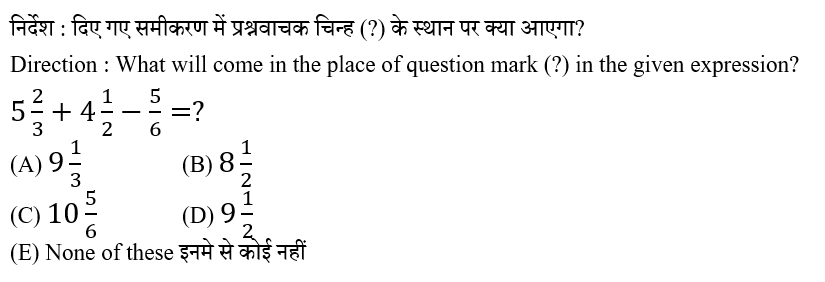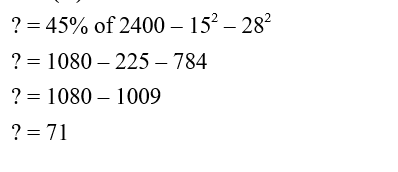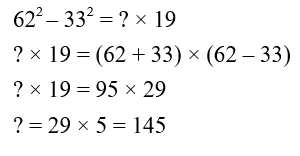Question 1:
निर्देश : दिए गए समीकरण में प्रश्नवाचक चिन्ह (?) के स्थान पर क्या आएगा?
Direction : What will come in the place of question mark (?) in the given expression?
?% of 600 = 15 × 12 + 15 × 8
Question 2:
निर्देश : दिए गए समीकरण में प्रश्नवाचक चिन्ह (?) के स्थान पर क्या आएगा?
Direction : What will come in the place of question mark (?) in the given expression?
? = 45% of 2400 – 152 – 282
Question 3: 
Question 4:
निर्देश : दिए गए समीकरण में प्रश्नवाचक चिन्ह (?) के स्थान पर क्या आएगा?
Direction : What will come in the place of question mark (?) in the given expression?
16% of 18% of 2500 + 56 ÷ 2 = ?2
Question 5:
निर्देश : दिए गए समीकरण में प्रश्नवाचक चिन्ह (?) के स्थान पर क्या आएगा?
Direction : What will come in the place of question mark (?) in the given expression?
25% of 600 + 40% of 400 = ? + 110
Question 6:
निर्देश : दिए गए समीकरण में प्रश्नवाचक चिन्ह (?) के स्थान पर क्या आएगा?
Direction : What will come in the place of question mark (?) in the given expression?
432 ÷ 18 – 798 ÷ 19 + 736 ÷ 16 = ?
Question 7:
निर्देश : दिए गए समीकरण में प्रश्नवाचक चिन्ह (?) के स्थान पर क्या आएगा?
Direction : What will come in the place of question mark (?) in the given expression?
(672 × 528) ÷ (12 × 24) + 268 = 50 × ?
Question 8:
निर्देश : दिए गए समीकरण में प्रश्नवाचक चिन्ह (?) के स्थान पर क्या आएगा?
Direction : What will come in the place of question mark (?) in the given expression?
622 – 332 = ? × 19
Question 9:
निर्देश : निम्नलिखित श्रृंखला में प्रश्नवाचक चिन्ह (?) के स्थान पर क्या आएगा?
Direction : What will come in place of the question mark (?) in the following series?
9, ?, 18, 54, 216, 1080
Question 10:
निर्देश : निम्नलिखित श्रृंखला में प्रश्नवाचक चिन्ह (?) के स्थान पर क्या आएगा?
Direction : What will come in place of the question mark (?) in the following series?
128, 32, 16, ?, 12, 15




